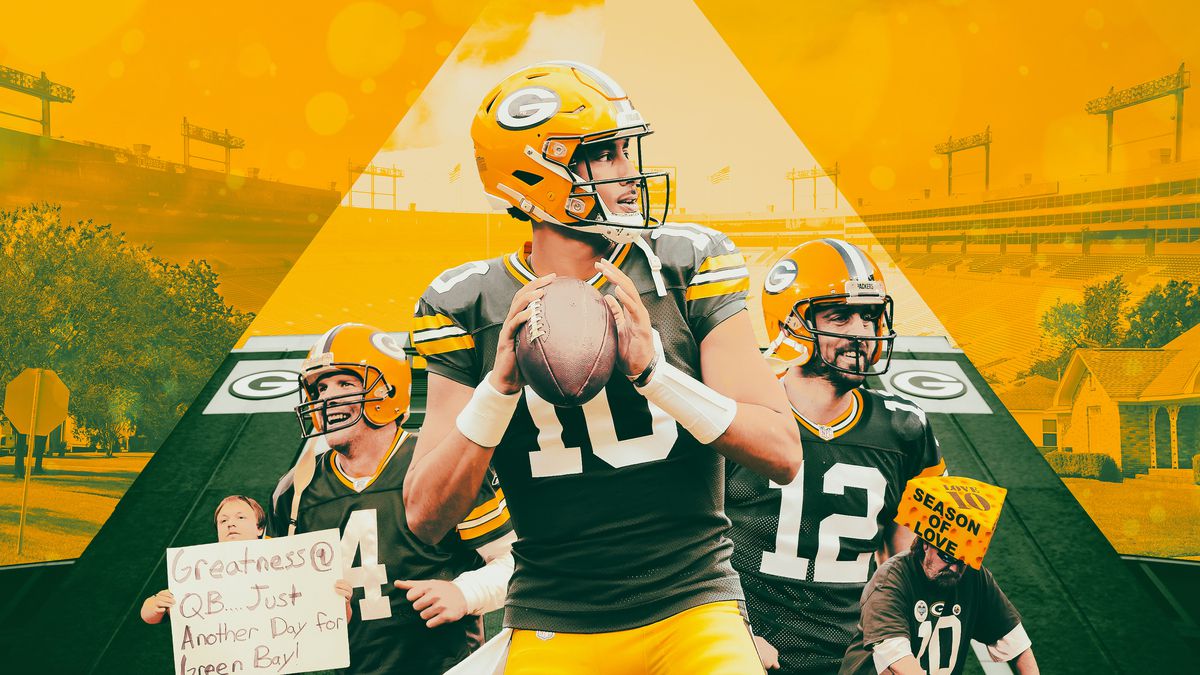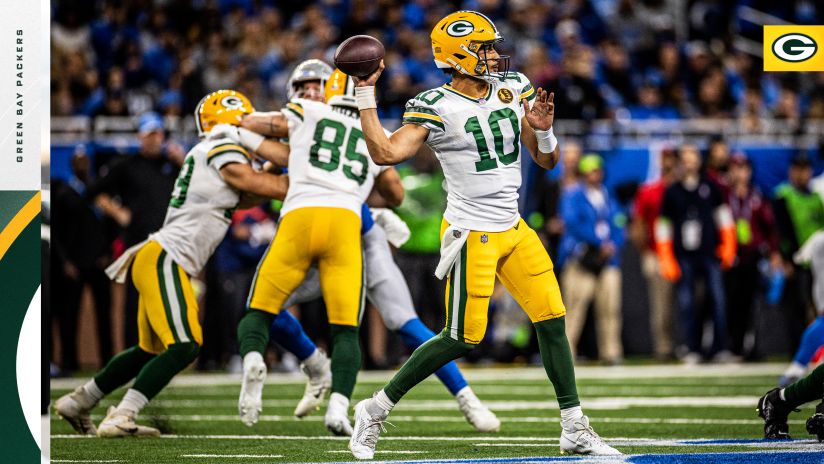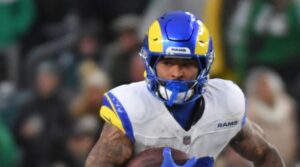
Green Bay Packers GM Brian Gutekunst expressed his interest in regularly drafting quarterbacks. Despite having a talented quarterback in Jordan Love and a promising backup in Sean Clifford, Gutekunst mentioned at the Scouting Combine that he aims to return to the approach established by Ron Wolf.
During Brett Favre’s tenure as quarterback, Ron Wolf, the former Green Bay Packers general manager, selected six quarterbacks in seven drafts, including successful picks like Mark Brunell, Matt Hasselbeck, and Aaron Brooks.
Current general manager Brian Gutekunst expressed a desire to return to this strategy of drafting multiple quarterbacks, emphasizing the importance of having young, talented players for development.
In the NFL Draft preview series, quarterbacks beyond the first round are evaluated, starting from No. 7. The rankings intentionally exclude the top six quarterbacks who are expected to be selected in the first round, such as Caleb Williams, and only prospects who fit certain physical criteria are considered. All statistical analysis is sourced from Pro Football Focus.
No. 7: Michael Pratt, Tulane
Standing at 6 feet 2 and a half inches, weighing 217 pounds, with a hand size of 9 and a quarter inches. Pratt did not participate in the 40-yard dash but scored an 8.27 Relative Athletic Score (RAS).
Pratt accumulated impressive stats during his four-year tenure at Tulane, amassing 9,611 passing yards and 90 touchdowns. In his senior year, he completed 65.4 percent of his passes, throwing for 2,406 yards with 22 touchdowns and five interceptions. His NFL passer rating stood at a notable 110.5, slightly down from 111.9 in 2022. Among 37 FBS-level quarterbacks in this draft class with a minimum of 280 dropbacks, Pratt ranked 15th in adjusted completion percentage, accounting for drops as completions.
Additionally, among the same pool of quarterbacks, Pratt ranked sixth in passer rating (115.8) on passes thrown 20-plus yards downfield. Notably, he ranked ninth in completion percentage (47.7) when facing pressure on 90 dropbacks and was third in under-pressure touchdown passes, tying with Drake Maye and surpassing Michael Penix by one. Despite displaying a strong arm and adequate athleticism, Pratt’s turnover-worthy-play rate is a concern, although it may improve with faster decision-making.
No. 8: Joe Milton, Tennessee
Measuring 6 feet 5 and an eighth inches, weighing 235 pounds, with a hand size of 10 and a quarter inches. Milton ran the 40-yard dash in 4.62 seconds and did not receive a RAS score.
Over six seasons split between Michigan and Tennessee, Milton accumulated 5,353 passing yards and 37 touchdowns. In his sole full season as a starter in 2023, he completed 64.7 percent of his passes for 2,813 yards, registering 20 touchdowns and five interceptions, resulting in a passer rating of 102.0. Milton also contributed 299 rushing yards and seven rushing touchdowns. Among FBS-level quarterbacks with at least 280 dropbacks, he ranked 17th in adjusted completion percentage.
When facing pressure on 90 dropbacks, Milton ranked 32nd in completion percentage (39.1%), yet he ranked third in yards per attempt (9.1). Additionally, he ranked 20th in passer rating (90.8) on passes thrown 20-plus yards downfield among FBS-level quarterbacks in this draft class. While possessing a strong arm and impressive size and athleticism, Milton’s ranking is tempered by concerns about his consistency and pocket presence.
No. 9: Spencer Rattler, South Carolina
Standing at 6 feet 0 and a half inches, weighing 211 pounds, with a hand size of 9 and 7/8 inches. Rattler clocked a 4.95-second 40-yard dash and received a 4.00 Relative Athletic Score (RAS).
Following three years at Oklahoma, Rattler transferred to South Carolina for his final two seasons. During his fifth-year senior campaign in 2023, he completed 68.9 percent of his passes for 3,186 yards, tallying 19 touchdowns against eight interceptions, resulting in an NFL passer rating of 99.1. Among 37 FBS-level quarterbacks in this draft class with at least 280 dropbacks, he ranked fifth in adjusted completion percentage.
When facing pressure on 90 dropbacks, Rattler ranked 10th in completion percentage (47.1%). Among the same pool of quarterbacks, he ranked 20th in passer rating (89.5) on passes thrown 20-plus yards downfield. While possessing a decent arm, Rattler may lack the athleticism typically demanded in today’s NFL. His tendency to operate primarily from the shotgun formation could limit his potential fit in certain offensive schemes, such as Matt LaFleur’s Aaron Rodgers-centric system. Although he excels with predetermined reads, his overall performance may suffer without them. Concerns about his height may also impact his draft stock, influencing his ranking in this preview.
No. 10: Sam Hartman, Notre Dame
Measuring 6 feet 1 and an eighth inches, weighing 211 pounds, with a hand size of 9 and 3/4 inches. Hartman recorded a 4.80-second 40-yard dash and achieved a 3.81 Relative Athletic Score (RAS).
Hartman spent five years at Wake Forest, posting notable seasons of 4,228 yards and 39 touchdowns in 2021 and 3,701 yards and 38 touchdowns in 2022. Despite a slight decline in statistical output during his lone season with Notre Dame, he remained effective, completing 63.5 percent of his passes for 2,689 yards, with 24 touchdowns and eight interceptions, resulting in an NFL passer rating of 106.1. Among 37 FBS-level quarterbacks in this draft class with at least 280 dropbacks, he ranked 17th in adjusted completion percentage.
When facing pressure on 90 dropbacks, Hartman ranked 24th in completion percentage (41.2%). Among the same pool of quarterbacks, he ranked seventh in passer rating (115.7) on passes thrown 20-plus yards downfield. With considerable experience under his belt, Hartman displays anticipation and a keen understanding of the game, positioning him to compete for a roster spot immediately. With further coaching to refine his mechanics, he could develop into a reliable long-term backup quarterback.
No. 11: Carter Bradley, South Alabama
Standing at 6 feet 3 and an eighth inches, weighing 213 pounds, with a hand size of 9 and 3/8 inches. Bradley recorded a 4.82-second 40-yard dash and achieved an 8.56 Relative Athletic Score (RAS).
Following four seasons at Toledo with a part-time role, Bradley found success in two seasons at South Alabama, accumulating 5,995 passing yards and 47 touchdowns. In 2023, he completed 67.8 percent of his passes for 2,660 yards, tallying 19 touchdowns and seven interceptions, resulting in a passer rating of 102.3. Among 37 FBS-level quarterbacks in this draft class with at least 280 dropbacks, he ranked ninth in adjusted completion percentage.
When facing pressure on 90 dropbacks, Bradley finished 13th with a completion rate of 45.3 percent, accompanied by four touchdowns and four interceptions. Among the same pool of quarterbacks, he ranked 12th with a passer rating of 107.9 on passes thrown 20-plus yards downfield. Despite impressive statistics, Bradley’s tendency to throw a high percentage of passes behind the line of scrimmage might skew perceptions. While possessing the size and arm strength, he will likely require refinement in mechanics to fully capitalize on his potential.
No. 12: Devin Leary, Kentucky
Measuring 6 feet 1 and a quarter inches, weighing 215 pounds, with a hand size of 9 and a half inches. Leary did not participate in the 40-yard dash and received no Relative Athletic Score (RAS).
Leary spent his initial four seasons at NC State, boasting a notable 2021 campaign of 3,433 passing yards and 35 touchdowns against five interceptions. Transitioning to Kentucky in 2023, he completed 56.3 percent of his passes for 2,746 yards, tallying 25 touchdowns and 12 interceptions, resulting in an 88.7 passer rating. Among 37 FBS-level quarterbacks in this draft class with at least 280 dropbacks, he ranked 34th in adjusted completion percentage.
When facing pressure on 90 dropbacks, Leary finished 34th with a completion rate of 36.4 percent, accompanied by seven interceptions. Among the same pool of quarterbacks, he ranked 32nd with a 70.1 passer rating on passes thrown 20-plus yards downfield. Despite being slightly undersized, Leary possesses sufficient arm strength, positioning him as a promising developmental prospect. However, his performance under pressure and down the field, coupled with a failure to replicate his 2021 success, suggest he will require substantial refinement and development.
No. 13: Kedon Slovis, BYU
Measuring 6 feet 2 and a half inches tall, weighing 223 pounds, with a hand size of 9 and 7/8 inches. Slovis had stints at USC for three years, one year at Pitt, and his final season at BYU. During his standout freshman year at USC in 2019, he boasted a remarkable 71.9 percent completion rate, accumulating 3,502 yards and 30 touchdowns with nine interceptions. However, he failed to replicate this success in subsequent seasons, never reaching the 20-touchdown mark. At BYU, his performance dipped further, completing a career-low 57.5 percent of his passes for 1,716 yards, tallying 12 touchdowns against six interceptions, resulting in an 82.1 passer rating. Among 37 FBS-level quarterbacks in this draft class with at least 280 dropbacks, he ranked 36th in adjusted completion percentage at 67.2 percent.
When facing pressure on 90 dropbacks, Slovis ranked 36th with a completion rate of 36.1 percent. Among the same group of quarterbacks, he finished 31st with a 74.4 passer rating on passes thrown 20-plus yards downfield. His diminishing performance, inconsistent accuracy, and limited arm strength may hinder his prospects as a quarterback. However, considering the success of former BYU quarterback Taysom Hill as a versatile player, Slovis’s size and speed might offer him a role on an NFL roster.
No. 14: Austin Reed, Western Kentucky
Standing at 6 feet 1 and a half inches tall, weighing 220 pounds, with a hand size of 9 and 7/8 inches. Reed spent two seasons at Western Kentucky, accumulating 8,086 passing yards and 71 touchdowns. However, his numbers declined notably in 2023, posting a 61.5 percent completion rate, 3,340 yards, and 31 touchdowns with 11 interceptions. Despite this, he achieved an NFL passer rating of 95.1. Among 37 FBS-level quarterbacks in this draft class with at least 280 dropbacks, he ranked 25th in adjusted completion percentage at 70.2 percent. Prior to his time at WKU, he led West Florida to a Division II national championship in 2021.
When facing pressure on 90 dropbacks, Reed ranked 20th with a completion rate of 42.7 percent. Among the same group of quarterbacks, he ranked 27th with a passer rating of 81.1 on passes thrown 20-plus yards downfield. Although his statistics appear favorable at first glance, they are largely influenced by scheme. Reed heavily relied on passes behind the line of scrimmage, similar to Oregon’s Bo Nix. Despite this, his completion percentage did not reflect his reliance on short passes. He demonstrates a strong understanding of the game and the ability to evade pressure. However, his stature might present a challenge, although his sizable hands may appeal to the Packers.









